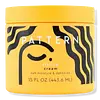What's inside
What's inside
 Key Ingredients
Key Ingredients

No key ingredients
 Benefits
Benefits

 Concerns
Concerns

 Ingredients Side-by-side
Ingredients Side-by-side

Water
Skin ConditioningOryza Sativa
Behentrimonium Methosulfate
Cocos Nucifera Oil
MaskingButyrospermum Parkii Oil
EmollientOlea Europaea Fruit Oil
MaskingCamellia Sinensis Leaf Extract
AntimicrobialSesamum Indicum Seed Oil
EmollientGlycine Soja Oil
EmollientAloe Barbadensis Leaf
MaskingRicinus Communis Seed Oil
MaskingOryza Sativa Bran Oil
EmollientMacadamia Ternifolia Seed Oil
EmollientPersea Gratissima Oil
Skin ConditioningAloe Barbadensis Leaf Juice
Skin ConditioningStearoxytrimethylsilane
EmollientSorbitol
HumectantSimmondsia Chinensis Seed Oil
EmollientAscorbic Acid
AntioxidantTocopherol
AntioxidantCaprylyl Glycol
EmollientScentenal
PerfumingWater, Oryza Sativa, Behentrimonium Methosulfate, Cocos Nucifera Oil, Butyrospermum Parkii Oil, Olea Europaea Fruit Oil, Camellia Sinensis Leaf Extract, Sesamum Indicum Seed Oil, Glycine Soja Oil, Aloe Barbadensis Leaf, Ricinus Communis Seed Oil, Oryza Sativa Bran Oil, Macadamia Ternifolia Seed Oil, Persea Gratissima Oil, Aloe Barbadensis Leaf Juice, Stearoxytrimethylsilane, Sorbitol, Simmondsia Chinensis Seed Oil, Ascorbic Acid, Tocopherol, Caprylyl Glycol, Scentenal
Water
Skin ConditioningButyrospermum Parkii Butter
Skin ConditioningCetearyl Alcohol
EmollientGlycerin
HumectantCeteareth-20
CleansingPolysorbate 60
EmulsifyingPEG-40 Hydrogenated Castor Oil
EmulsifyingPEG-120 Methyl Glucose Dioleate
EmulsifyingCocos Nucifera Oil
MaskingPhenoxyethanol
PreservativeHydroxyethylcellulose
Emulsion StabilisingPrunus Amygdalus Dulcis Oil
Skin ConditioningTheobroma Cacao Seed Butter
EmollientParfum
MaskingDisodium EDTA
Citric Acid
BufferingEthylhexylglycerin
Skin ConditioningAloe Barbadensis Leaf Extract
EmollientSodium Benzoate
MaskingSodium Sulfite
PreservativePotassium Sorbate
PreservativeCocos Nucifera Fruit Extract
EmollientPEG-60 Hydrogenated Castor Oil
EmulsifyingRosmarinus Officinalis Leaf Extract
AntimicrobialHelianthus Annuus Seed Oil
EmollientPhenethyl Alcohol
MaskingCaprylyl Glycol
EmollientCaryodendron Orinocense Seed Oil
EmollientHydrolyzed Wheat Protein
Skin ConditioningWater, Butyrospermum Parkii Butter, Cetearyl Alcohol, Glycerin, Ceteareth-20, Polysorbate 60, PEG-40 Hydrogenated Castor Oil, PEG-120 Methyl Glucose Dioleate, Cocos Nucifera Oil, Phenoxyethanol, Hydroxyethylcellulose, Prunus Amygdalus Dulcis Oil, Theobroma Cacao Seed Butter, Parfum, Disodium EDTA, Citric Acid, Ethylhexylglycerin, Aloe Barbadensis Leaf Extract, Sodium Benzoate, Sodium Sulfite, Potassium Sorbate, Cocos Nucifera Fruit Extract, PEG-60 Hydrogenated Castor Oil, Rosmarinus Officinalis Leaf Extract, Helianthus Annuus Seed Oil, Phenethyl Alcohol, Caprylyl Glycol, Caryodendron Orinocense Seed Oil, Hydrolyzed Wheat Protein
Alternatives
Ingredients Explained
These ingredients are found in both products.
Ingredients higher up in an ingredient list are typically present in a larger amount.
Caprylyl Glycol is a humectant and emollient, meaning it attracts and preserves moisture.
It is a common ingredient in many products, especially those designed to hydrate skin. The primary benefits are retaining moisture, skin softening, and promoting a healthy skin barrier.
Though Caprylyl Glycol is an alcohol derived from fatty acids, it is not the kind that can dry out skin.
This ingredient is also used as a preservative to extend the life of products. It has slight antimicrobial properties.
Learn more about Caprylyl GlycolCocos Nucifera Oil is obtained from the kernels of the coconut fruit. In other words, this is coconut oil.
Coconut Oil is rich in fatty acids with lauric acid making up the majority of these. It also contains linoleic acid. Due to this high fatty acid content, coconut oil helps trap moisture and soften skin.
Despite being antibacterial, coconut oil may not be great for acne-prone skin. It is comedogenic and may clog pores. This ingredient may not be safe for malassezia or fungal acne.
Note: Coconut Oil should not replace your sunscreen for UV protection. Studies show it only blocks about 20% of UV.
This oil is non-volatile and has a light scent.
The term 'fragrance' is not regulated in many countries. In many cases, it is up to the brand to define this term. For instance, many brands choose to label themselves as "fragrance-free" because they are not using synthetic fragrances. However, their products may still contain ingredients such as essential oils that are considered a fragrance.
Learn more about Cocos Nucifera OilWater. It's the most common cosmetic ingredient of all. You'll usually see it at the top of ingredient lists, meaning that it makes up the largest part of the product.
So why is it so popular? Water most often acts as a solvent - this means that it helps dissolve other ingredients into the formulation.
You'll also recognize water as that liquid we all need to stay alive. If you see this, drink a glass of water. Stay hydrated!
Learn more about Water